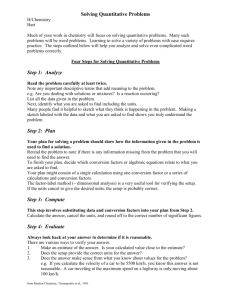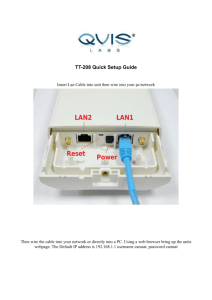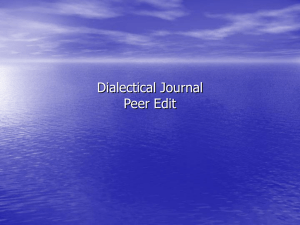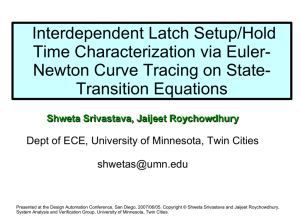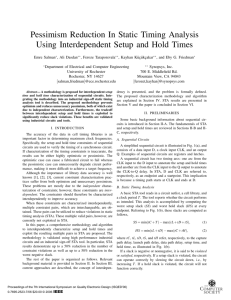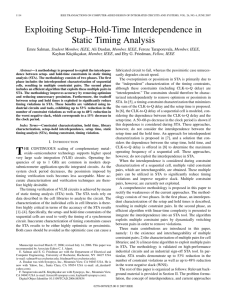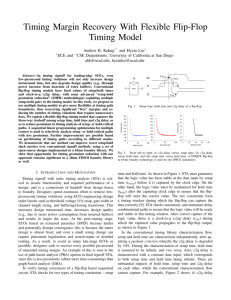Calibration of Setup and Hold time for Latches and Flip
advertisement
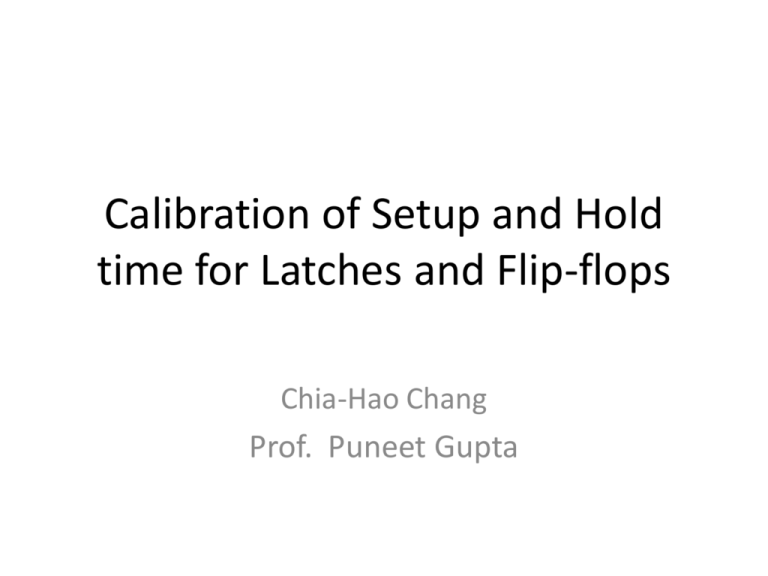
Calibration of Setup and Hold
time for Latches and Flip-flops
Chia-Hao Chang
Prof. Puneet Gupta
Outline:
1.
2.
3.
4.
5.
Definition of setup and hold time
Measurement methodology
Library file formulation
Library characterization tools
Reference
Definition of Setup and Hold Time
Setup and Hold Times Specification for
Rising-Edge-Triggered Flip-Flop
Setup and Hold Sepcification for
High-Enable Latch
[1]
When Violating the Setup or Hold Constraint :
extra delay
Voltage Keeper
Conventional TSPC Flip-Flop Design [2]
Will cause Clock-Q delay to increase or [3]
even flip the Output
Measurement Methodology(1/3)
[4]
Approaches for setup and hold time determination: [4]
1. Minimizing T_setup +T_hold with some given delay allowance
2. Minimizing T_setup + T_clk2Q [5] -> Maximize the Perfomance
3. (Industrial approach) 5-10% degradation in the minimal possible T_clk2Q delay
Measurement Methodology(2/3)
[7]
Measurement Methodology(3/3)
Searching methodologies for critical skew for the onset of metastability
1. Binary search (Mostly applied) : mouths of runtime for enterprise libraries[5]
2. Using Newton-Raphson method to solve Differential Equations of Metastability[6]
4x ~ 10x faster
A Transmission Gate
Based Positive-edge
triggered master-slave
register
Library File Formulation
To be calibrated:
setup_rising, setup_falling,
hold_rising, or hold_falling
The table requires the 9
searching processes for
different sets of indices
pin (D) {
direction : input;
...
timing () {
related_pin : "CK";
timing_type : "setup_rising";
rise_constraint ("setuphold_template_3x3") {
index_1("0.4, 0.57, 0.84"); /* Data transition Time*/
index_2("0.4, 0.57, 0.84"); /* Clock transition Time*/
values( /* 0.4 0.57 0.84 */ \
/* 0.4 */ "0.063, 0.093, 0.112", \
/* 0.57 */ "0.526, 0.644, 0.824", \
[10]
/* 0.84 */ "0.720, 0.839, 0.930");
…
Setup time constraints for
output rising case
Library Characterization Tools
LibDev Specific Software (~2008)[9]
Company
Layout
Characterization
Altos Design Automation
Liberate
Cadence
SignalStorm
Optimization
Fenix Design Automation
Crossfire
Legend Design
Technology
Library Technologies
Magma Design
Automation
CharFlo-Memory
LibChar
Library Creator
Prolific
ProGenesis
Radix Tools
Synopsys
VeriPool
Z Circuit
Zenasis Technologies
CellOpt, LowSkew
SiliconSmart
Nangate
Sagantec
SIMUCAD Design
Automation
Verification
Library Creator, Library
Characterizer
Library Creator
Std. cell library
characterization.
xlicdsm
SiClone, SiFix
Library Creator, Liberty
Analyzer
SiFix, DFM-Fix
AccuCell
Cadabra
Liberty NCX
Circuit Explorer
GSpice (free)
ZChar
Liberty parser, Liberty
screener, Library
Compiler
Library Analyzer
ZenTime-CT
Reference(1/2)
[1] W. Roethig, “Library Characterization and Modeling for 130 nm and 90 nm SOC Design,”
Proceedings of the IEEE International SOC Conference, pp. 383–386, September 2003.
*2+ Wikipedia, “Flip-flop (electronics)”
http://en.wikipedia.org/wiki/Flip-flop_(electronics)
*3+ K. Yang, “Clocking Methodology and Flip-Flops,” EE215B lecture note, Winter 2010
[4] S. Sundareswaran,“Statistical Characterization For Timing Sign-Off: From Silicon to Design and
Back to Silicon,” Doctorial thesis of the University of Texas at Austin, 2009
[5] V. Stojanovic and V.G. Oklobdzija, “Comparative Analysis of Master- Slave Latches and FlipFlops for High-Performance and Low-Power Systems,” IEEE Journal of Solid-State Circuits, Vol.
34, No. 4, pp. 536–548, April 1999.
[6] Srivastava, S.; Roychowdhury, J.; , "Rapid and Accurate Latch Characterization via Direct
Newton Solution of Setup/Hold Times," Design, Automation & Test in Europe Conference &
Exhibition, 2007. DATE '07 , vol., no., pp.1-6, 16-20 April 2007
[7] Salman, E.; Dasdan, A.; Taraporevala, F.; Kucukcakar, K.; Friedman, E.G.; , "Pessimism reduction
in static timing analysis using interdependent setup and hold times,"Quality Electronic
Design, 2006. ISQED '06. 7th International Symposium on , vol., no., pp.6 pp.-164, 27-29
March 2006
[8] Srivastava, S.; Roychowdhury, J.; , "Independent and Interdependent Latch Setup/Hold Time
Characterization via Newton–Raphson Solution and Euler Curve Tracking of State-Transition
Equations," Computer-Aided Design of Integrated Circuits and Systems, IEEE Transactions on ,
vol.27, no.5, pp.817-830, May 2008
Reference(2/2)
[9] Review of Library Develop tools in the personal website of Oleg S. SEVALNEV :
http://olegsevalnev.tripod.com/
[10] J. Bhasker and Rakesh Chadha, “Static Timing Analysis for Nanometer Designs: A Practical
Approach. Springer,” first edition, April 2009.
Related Study
• Setup and Hold Time interdependence
Modeling in Static Timing Analysis [7][8]
Require more SPICE simulation



